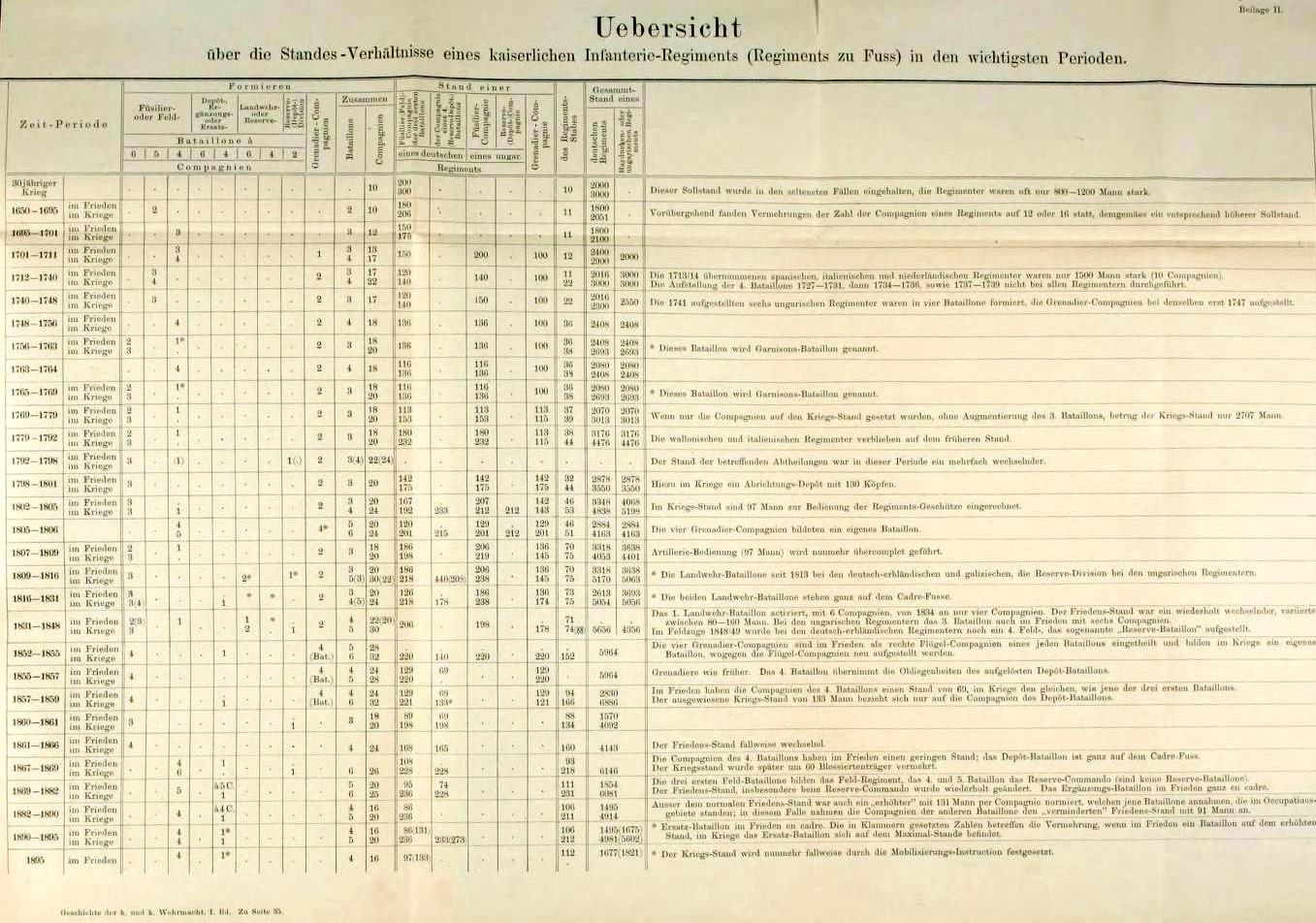Military Matters
0. Special Tools 1. Periods & Archives | 2. Karen Hobbs | 3. Carl Kotlarchik | 4. Dave Dreyer | 5. Maps | 6. Links
0. Special Tools |
|
 |
Wrede Alfons Frhr von, Semek Anton, Geschichte der K. und K. Wehrmacht: Die Regimenter, Corps, Branchen und Anstalten von 1618 bis Ende des XIX. Jahrhunderts, 5 vol., Austro-Hungarian Monarchy, Kriegsarchiv Mittheilungen, L. W. Seidel, 1901. Two sources to view:
https://archive.org/details/geschichtederkun00wred/page/n6/mode/2up
https://library.hungaricana.hu/hu/view/MitKuKKriegsArch_1898_Supplement_01/?pg=53&layout=s
Overview - on the status of an imperial infantry regiment (regiments on foot) in the most important periods.

[Above: Uebersicht - über die Standes-Verhälaltnisse eines kaiserlichen Infanterie-Regiments (Reginents zu Fuss) in den wichtigsten Perioden.] Source: Wrede Alfons Frhr von, Semek Anton, Geschichte der K. und K. Wehrmacht: Die Regimenter, Corps, Branchen und Anstalten von 1618 bis Ende des XIX. Jahrhunderts, 5 vol., Austro-Hungarian Monarchy, Kriegsarchiv Mittheilungen, L. W. Seidel, 1901]
Table of the Recruiting Locations for the Austro-Hungarian Army Infantry Regiments
in the Kingdom of Hungary by County from 1781-until 1883.

1.Periods & Archives |
|
 |
Determining the time period for searching military records -
The three major time periods to consider are: 1. Pre-1867
- Records centrally maintained at the
Vienna War Archives. These records include soldiers from the entire Empire including individuals from Austria, the Czech regions, Galicia, and all of Hungary.
2. 1867 to 1918
- Records maintained by Austria and by Hungary separately. Austria kept the records for the regions they directly administered, including Galicia and the Czech regions of Bohemia and Moravia. Hungary kept those for everyone in their kingdom, which included the Slovaks and other slavs within their borders. By treaty, these records were to be sent to the successor countries but there is a lot of conflicting information as to what has happened to these records (see section below on Czech Military Records).
3. Post-1918
- Records maintained by the states of Czechoslovakia (1st and 2nd Republic) and Slovakia (1st Republic) as well as the other successor nations of Poland, Yugoslavia, Romania, the Ukraine, and various countries formed after Yugoslavia was broken up. "The key to finding military records is to determine in which regiment the soldier served. In Alphons Wrede’s book: Geschichte
der k. und k. Wehrmacht (History of the Austro-Hungarian Armed Forces) volume 1, there are
charts for each region of the Empire called the Uebersicht der Werb- (Ergänzungs-) Bezirks-Eintheilung von 1781 bis 1889. These
charts show in which counties each infantry regiment recruited during any period of time. This book is available from the FHL on film 1187917 item 2." [source:
Carl Kotlarchik]
PRAGUE
Vojenský ústřední archiv
Sokolovská 136 / 24
186 00 Praha 8 – Karlín
Czech Republic
The War Archive in Vienna, which is part of the Austrian State Archives, keeps personnel records for soldiers born before 1865, military church records, and many important records related to World War I. Database of archival sources of the Austrian State Archive: www.archivinformationssystem.at/archivplansuche.aspx
Österreichisches Staatsarchiv
Abteilung Kriegsarchiv
Nottendorfer Gasse 2
A-1030 Vienna
Austria
Austrian National Library
-
Great Patriotic War
1941-1945, Prisoner
of War / Forced Labor
Application Form for archival information, archival
copies of the newsletter on the fact of abduction
for forced labor during the Great Patriotic War. Site is in
Russian
www.statearchive.ru/401
but click here for the
Google Translation of Link
(Russian to English).

2. Karen Hobbs |
|
 |
| |
|
 |
Karen Lucille (Kiehn) Hobbs
Oct 8, 1935 - May 2, 2013 Karen Hobbs will be missed!
www.shrineofremembrance.com/karen-l-hobbs/
Austrian Regiments and Where They Recruited
by Karen Hobbs
An extensive collection of data she has accumulated in how to find our Danube Swabian ancestors through the military records. Its superb!
Austria-Hungarian
Military Records on CD by Karen Hobbs.
Since she has passed away I'm not sure how to obtain a CD. |

3. Carl Kotlarchik |
|
 |
To find
military records
for the
Austro-Hungarian
Army, one
first needs to
determine where
and how to look
for them since
they were kept
at different
locations during
various periods
of time. The
records were
also kept
differently for
the various
states within
the Empire.
Consequently, it
can be a little
confusing if one
does not
understand a bit
about the
history of the
Austrian Empire
and the
subsequent
Austro-Hungarian
Empire. Excerpts
from:
Austro-Hungarian
Army Records by
Carl Kotlarchik
(great site!),
including the
following
notable excerpts:
The Ausgleich -"A compromise was reached in 1867, know as the Ausgleich,
by which Hungary was given equal status with Austria. The Austrian Emperor was still recognized as being the King of Hungary but the Hungarian diet regained powers over Hungarian lands and the people residing within their borders like the Slovaks and Ruthenians. The Empire now became known as the Austro-Hungarian Empire. It would last until the end of World War I, after which, the Empire was broken down into many separate countries. After 1867, a Hungarian homeland army emerged. In addition to the joint Austro-Hungarian Army, known as the Royal and Imperial Army (the k.u.k.), Hungary formed a new, separate army which they called the
Honved known
as the Royal Hungarian Army (k.u.). Austria already had its own homeland army which they called the Landwehr or
the Imperial Royal Army (the k.k.). Men
could be conscripted to serve in either the joint army or their homeland army."
"The Director of the Military Archives in Budapest, Col. Dr. Attila Bonhardt, has made the following statement about the Hungarian military records: "all drafting and recruitment Lists and Military Registers of soldiers born in Hungary between 1850 and 1899 and served in the Austro-Hungarian Army were totally destroyed during the Second World War. There are only the Decoration Proposals of the Hungarian WWI-soldiers at our keeping and preservation at the War History Archives
in Budapest".
The Kriegsarchiv in Vienna defines the abgangsklassen as follows:
Abgang 1. Klasse = Officers and soldiers who are transferred to other units but remain in the army. Also, officers who retire on pensions (note these can sometimes be in the Abgang 2. Klasse).
Abgang 2. Klasse = Only officers and cadets who are discharged from the army or are killed.
Abgang 3. Klasse = Non-commissioned officers and enlisted men who are discharged from the army or are killed.

4. David Dreyer |
|
 |
BANATERS IN AUSTRIAN MILITARY RECORDS (PDF) Compiled by David Dreyer
May 2005 Revised and Expanded March 2006 and June 2007 © 2005, 2006, 2007 by David Dreyer
5.
Maps |
|
 |
Österreich unter der Enns (1773–1781) - First Military Survey
|
Temeschwarer Banat (1769–1772) - First Military Survey
|
| 1898 - Regiment Map of Austro-Hungarian Troop Locations
|
 |
1910
- 3rd Military
(The Monarchy III.)
Mapping Survey of
Austria-Hungary
(includes
many small villages some of which no
longer exist)
Distribution
of
the
general
geographical
map
of
Central
Europe. Click the sections on the overview map to download individual map sheets (size of a section is about 1.5-5.5 MB).
|
Sample snippet of my
ancestral village Mercydorf in Banat, by
clicking on Temesvar.
 |
6.
Links |
|
 |
https://www.napoleon-series.org/military/organization/Austria/ArmyStudy/c_AustrianArmyBohemia.html
Austro-Hungarian Land Forces 1848-1918
|